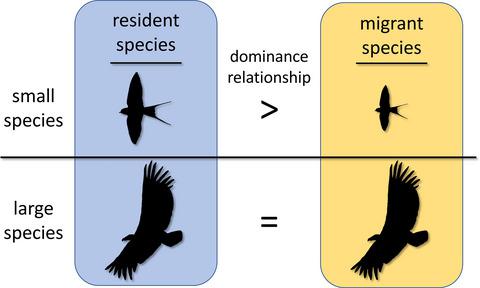当前位置:
X-MOL 学术
›
J. Evol. Biol.
›
论文详情
Our official English website, www.x-mol.net, welcomes your
feedback! (Note: you will need to create a separate account there.)
Size‐dependent costs of migration: Migrant bird species are subordinate to residents, but only at small body sizes
Journal of Evolutionary Biology ( IF 2.1 ) Pub Date : 2020-01-20 , DOI: 10.1111/jeb.13583 Paul R Martin 1 , Haley L Kenyon 1 , Leah Hayes 1
Journal of Evolutionary Biology ( IF 2.1 ) Pub Date : 2020-01-20 , DOI: 10.1111/jeb.13583 Paul R Martin 1 , Haley L Kenyon 1 , Leah Hayes 1
Affiliation

|
Migrant species are commonly thought to be poor competitors in aggressive interactions with resident species. However, no studies have tested whether this relationship is widespread. Here, we compare the behavioural dominance of closely related species of migratory and nonmigratory birds, testing whether migrants are consistently subordinate to resident species in aggressive contests. We compiled published behavioural dominance data involving migrant and resident congeners, gathering additional data on the body mass and migratory distance of each species. Focal species included a diverse array of birds (28 taxonomic families, 12 orders) from around the world. We found that migrant species are usually subordinate to resident species, but that this relationship disappears at larger body sizes. For smaller birds (<500 g), resident species were behaviourally dominant in 83%–88% of comparisons; for larger birds (>500 g), resident species were dominant in only 25%–30% of comparisons. The relative difference in body mass best predicted dominance relationships among species, with larger species dominant in 80%–84% of comparisons. When migrant and resident masses were equal, however, resident species were still more likely to be dominant in smaller birds, suggesting that other factors may also contribute to the subordinate status of migrants. Overall, our results suggest that in smaller species, the evolution of migration is associated with lighter weights and other traits that compromise the competitive abilities of migrants relative to residents. In contrast, larger species appear able to evolve migration without compromising their size or competitive abilities in aggressive contests, suggesting size‐dependent constraints on the evolution of migration.
中文翻译:

与体型相关的迁徙成本:候鸟物种从属于居民,但仅在体型较小时
迁徙物种通常被认为是与本地物种进行积极互动的不良竞争者。然而,没有研究测试这种关系是否广泛存在。在这里,我们比较了迁徙鸟类和非迁徙鸟类的密切相关物种的行为优势,测试迁徙鸟类是否在侵略性竞赛中始终从属于常驻物种。我们汇编了已发布的涉及迁徙和常住同类的行为优势数据,收集了关于每个物种的体重和迁徙距离的额外数据。重点物种包括来自世界各地的各种鸟类(28 个分类科,12 个目)。我们发现迁徙物种通常从属于常驻物种,但这种关系在体型较大时消失。对于较小的鸟类(<500 克),在 83%–88% 的比较中,常驻物种在行为上占优势;对于较大的鸟类(> 500 g),仅在 25%–30% 的比较中常驻物种占优势。体重的相对差异最能预测物种之间的优势关系,较大的物种在 80%–84% 的比较中占优势。然而,当迁徙者和常驻者数量相等时,常驻物种仍然更有可能在较小的鸟类中占优势,这表明其他因素也可能导致迁徙者的从属地位。总体而言,我们的结果表明,在较小的物种中,迁徙的进化与较轻的体重和其他损害迁徙者相对于居民的竞争能力的特征有关。相比之下,
更新日期:2020-01-20
中文翻译:

与体型相关的迁徙成本:候鸟物种从属于居民,但仅在体型较小时
迁徙物种通常被认为是与本地物种进行积极互动的不良竞争者。然而,没有研究测试这种关系是否广泛存在。在这里,我们比较了迁徙鸟类和非迁徙鸟类的密切相关物种的行为优势,测试迁徙鸟类是否在侵略性竞赛中始终从属于常驻物种。我们汇编了已发布的涉及迁徙和常住同类的行为优势数据,收集了关于每个物种的体重和迁徙距离的额外数据。重点物种包括来自世界各地的各种鸟类(28 个分类科,12 个目)。我们发现迁徙物种通常从属于常驻物种,但这种关系在体型较大时消失。对于较小的鸟类(<500 克),在 83%–88% 的比较中,常驻物种在行为上占优势;对于较大的鸟类(> 500 g),仅在 25%–30% 的比较中常驻物种占优势。体重的相对差异最能预测物种之间的优势关系,较大的物种在 80%–84% 的比较中占优势。然而,当迁徙者和常驻者数量相等时,常驻物种仍然更有可能在较小的鸟类中占优势,这表明其他因素也可能导致迁徙者的从属地位。总体而言,我们的结果表明,在较小的物种中,迁徙的进化与较轻的体重和其他损害迁徙者相对于居民的竞争能力的特征有关。相比之下,











































 京公网安备 11010802027423号
京公网安备 11010802027423号